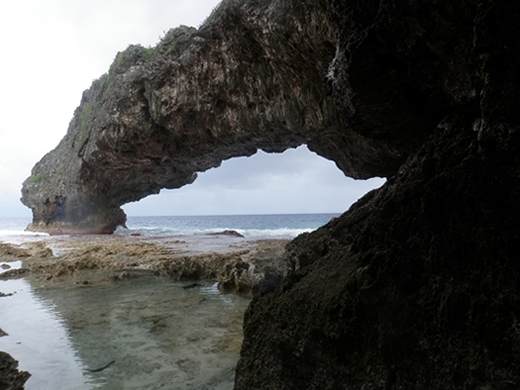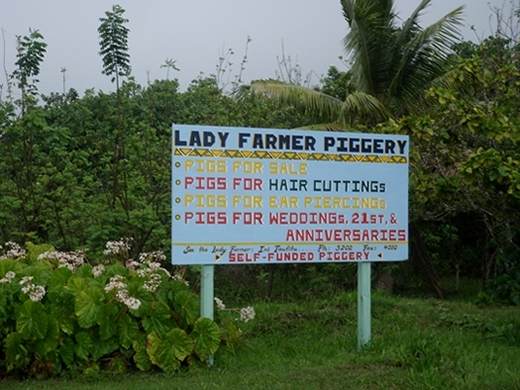Niue S18 37 W174 00

|
After an uncomfortable sail in falling winds we ended up motoring the last 100 miles to this isolated but spectacular island 2,400 km from New Zealand. When we first saw it we were taken aback, it is unlike any of the other islands we have seen. It is long, higher than atolls but not very high and looks completely level, it looked like a verdant thick crust pizza floating in the ocean – sorry Niue. As we got nearer we could see the low coral cliffs spiky, rutted with caves and being pounded by the ocean; the verdant topping of palms, chestnut, acacia and others lay thickly above. We had come to the largest raised coral atoll in the world which has a unique landscape of deeply weathered coral rock. Having a rain forest climate it is covered in lush vegetation although there are not the enormous trees of some rain forests, possibly due to the thin soils or the porous rocks. There are no rivers on the island but there is no shortage of water as the limestone simply soaks it up. There are caverns and caves everywhere and some impressive coastal landforms.
The resident population of about 1,500 is much reduced from a peak of 5,200 in the 1966. However, there are another 15,000 Niueans living in New Zealand. Niue is an independent country in free association with New Zealand; all Niueans have New Zealand citizenship, use New Zealand currency and are subjects of the Queen. The people are very religious with churches everywhere and on Sunday there are strict laws as to what is allowed. For instance you are not allowed to fish, swim or snorkel on Sunday! We were one of about 6 boats on the moorings provided by the Niue Yacht Club. The water is too deep and the bottom too steeped in coral chasms to allow for safe anchorage. The Yacht Club exists solely for visitors, we were the 205th boat to arrive this year. Yachts are an important part of the tourist industry here making up 27% of the total number of visitors. There is only 1 flight per week from New Zealand, only 100 beds for visitors and no big hotels. To explore the island we shared a car for the day with Kathy and Jeremy from Sal Darago. Our first stop was the pools at Limu where the water is shallow and protected by the reef but also very cold in the top few inches as a fresh water underground stream comes out there.
The colours were stunning as was the underwater fish life. You can see the layer of fresh water running over the salt water where the fish are swimming.
Our next stop was at some magnificent limestone arches reminiscent of Durdle Door in Dorset.
However, it was one up on Dorset in having limestone caves only a stone's throw away.
We returned to the car and passed this improbable sign.
When we recovered from whatever overcame us, all was to be revealed as we passed this scene...
and some rather amateur pig butchery.... ................. all in the pouring rain!
The event? A hair cutting and ear piercing
ceremony.............. an 8 year old boy was about to have his hair cut for the
first time and a girl of 11 was to have her ears pierced. The large number of
guests had apparently donated to this family event and in return were being
given large amounts of pork, chicken and taro. We still do not really know what
the origin or the significance of the event was, we were told there is no
special age for this, just when the family can afford it. Any further
information would be happily received. After this stop we went on to a Noni farm where they produce, on a large scale, the pressed juice form this smelly but ubiquitous plant that is used as a tonic and cure all throughout Polynesia. The taste is moderately disgusting but we bought a litre and Lorraine is testing its efficacy with a daily dose. We finished the day with a visit to the east coast where the landscape has been eroded into all sorts of fantastic shapes by the continual action of the salt spray on the soluble limestone.
But within this dramatic scenery was an oasis of palms.
We had a fascinating day touring the island. We even had a beer with the Minister for Tourism as we sheltered in his bar while the heavens opened. Sadly we do not have a photo of him but at a local market we met this lovely lady.
This island deserves to be visited more
people. The island depends on a lot of external support mostly from New Zealand but we also noticed investment from China and the EU. We were told that the Chinese were very keen to step in should the New Zealand government ever decide to reduce its commitments. The exports at the moment consist of taro, honey ,fish and noni. Increased tourism would help to reduce the precarious nature of the economy and hopefully encourage more of the people to stay on the island. There are many abandoned buildings on the island and many graves in amongst the forest trees The impression is of an island that is at a watershed where it could develop or simply fade away. There is much to praise here. The tourist office was one of the best we have been in (light years ahead of the surly reception of some Caribbean Islands!) Every single person we spoke to whether native or New Zealander were unfailingly polite and helpful and in the short time we have been here we have seen some really unique landscapes.
|











